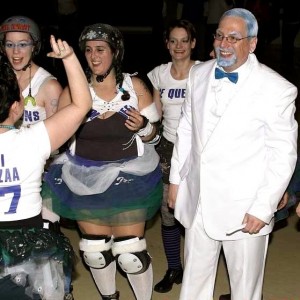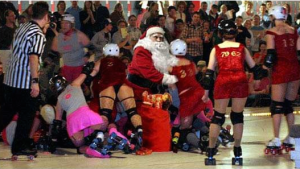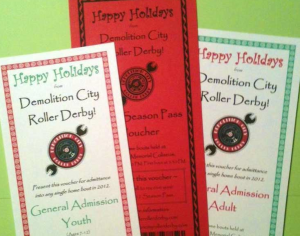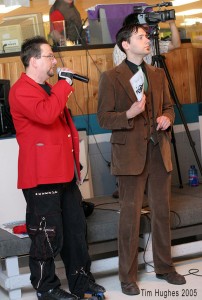
 Put on your party boutfit. Roller derby turns 82 this year and we’re celebrating in a big way during the inaugural World Roller Derby Week (August 13-19). Join us at two exciting events in Chicago or come out in summer and fall to donate at one of our Red Cross roller derby blood drives.
Put on your party boutfit. Roller derby turns 82 this year and we’re celebrating in a big way during the inaugural World Roller Derby Week (August 13-19). Join us at two exciting events in Chicago or come out in summer and fall to donate at one of our Red Cross roller derby blood drives.
How much do you know about roller derby? Here’s some trivia: Chicago is the birthplace of roller derby and the sport is one of a just handful invented in the U.S.
If you’re in Chicago (or… need a good excuse to visit), celebrate the big 82 and World Roller Derby Week at these two events.
Celebrate Roller Derby’s Birthday and Birthplace
Happy Birthday Roller Derby. Join roller derby skaters from across the Midwest at Coliseum Park for a skate and cake. Junior derby skaters will serve cake to passersby and we’ll honor original players. Athletes, fans and families from roller derby are encouraged to attend. Sunday, August 13, 12:30-2:00 PM, free.
Time Hop. Travel back in time and into the future at Fleetwood Roller Rink. This jam-packed double-header explores the past, present and future of roller derby. Saturday, August 19, 2-6 PM, adults $15, youth $5. Midwest All Stars’ home teams will play the first game under the classic 1970’s rule-set, while wearing commemorative uniforms.
The second game showcases young, emerging talent from the Midwest JRDA member leagues in a regulation level-three junior game. Artistic and speed skaters will put on an action-packed show at halftime.
Can’t be there in person? Be there in social. Catch the action or give a shoutout at #TimeHop2017.
Nationwide Roller Derby Blood Drives
The 4th Annual Make ‘Em Bleed derby blood drives roll out again this year, in partnership with Brown Paper Tickets and The American Red Cross. They will be going on coast-to-coast and for the first time, rocking the Midwest with a blood drive in Chicago (home of our newest office) on October 29.
Roller derby athletes will offer autographs, photo opportunities and more, making these community service events the most popular blood drives of the year in many of the cities they occur.
Summer is a difficult time for the Red Cross to get blood donations and they could really use your help. Make ‘Em Bleed roller derby blood drives have collected more than 900 units of blood over the past four years–enough to have helped save up to 2,700 lives.
To pre-register as a donor visit the Red Cross, tap “Find a Drive,” and enter the sponsor code, Derby.
There’s still time for your league to join this wonderful effort. Email derbyblooddrive(at)gmail(dot)com if you’re interested. And catch all the inspiration at #MakeEmBleed.
Make ’Em Bleed Red Cross Blood Drives 2017
Wednesday, July 26 (Pottstown, Pennsylvania): Rockstar Roller Derby from 2-7 pm at Ringing Hill Fire Company, 815 White Pine Lane.
Saturday, July 29 (San Jose, California): Silicon Valley Roller Derby from 10 am to 4 pm at Silver Creek Sportsplex, 800 Embedded Way.
Saturday, Aug. 5 (St. Petersburg, Florida): Deadly Rival Roller Derby from 5-7 pm at The Slayground, 4033 35th St N. (donors asked to sign-up here.)
Friday, Aug. 11 (Woodbridge, New Jersey): Dirty Jersey Roller Girls at a time to be announced at the VFW Post.
Sunday, Aug. 13 (Chicago, Illinois): Roller derby athletes from across the Midwest for the inaugural World Roller Derby Week, a public skate-and-cake blood donor pledge event at Coliseum Park, commemorating the public debut of the sport at that location in Chicago in 1935.
Friday, Aug. 18 (Santa Cruz, California): Santa Cruz Derby Girls from 9 am to 3 pm at Santa Cruz Strength, 151 Harvey West Blvd Suite D.
Friday, Aug. 18 (Livermore, California): Quad City Derby Bombshells at a time to be announced at Asbury United Methodist Church, 4743 East Ave.
Saturday, Aug. 19 (Chicago, Illinois): Roller derby athletes from across the country for Time Hop at Fleetwood Roller rink. This bout is also a public pledge to donate event where roller derby athletes will skate in the style that the sport made its debut in Chicago 82 years ago, in 1935. A limited number of tickets are available online through Brown Paper Tickets here.
Thursday, Aug. 25 (Santa Rosa, California): Resurrection Roller Girls and the Sonoma Roller Derby; at a time to be announced at the American Red Cross, 5297 Aero Drive. Both leagues have teamed-up for this blood drive in competition for which league can attract the most blood donor registrants, in competition for the Brown Paper Tickets cup.
Saturday, Sept. 9 (Hollister, California): The Faultline Derby Devilz from 10 am to 4 pm at the shopping center at 580 Tres Pinos Road.
Saturday, Sept. 23 (Poteau, Oklahoma): The Leflore County Maidens of Mayhem from 10 am to 4 pm at the Red Cross Bloodmobile at 1914 N. Broadway St.
Sunday, Oct. 29 (Chicago, Illinois): Roller derby leagues from across the Midwest at from 10 am to 3 pm at The American Red Cross of Chicago & Northern Illinois, 2200 West Harrison Street Chicago, IL 60612.
Sunday, Oct. 29 (Phoenix, Arizona): Arizona Derby Dames from 10 am to 4 pm at 2517 W. McDowell Road, Suite 118.
Saturday, January 6 (Poteau, Oklahoma): Leflore County Maidens of Mayhem Roller Derby Team from 10 a.m. to 4 p.m. at 1914 N. Broadway St.
Saturday, Jan. 13, 2018 (Tulsa, Oklahoma): Tulsa’s Roughneck Roller Derby from 12 to 6 pm at Rhema Bible Church,1025 W Kenosha St, Broken Arrow, OK.
Saturday, February 10 (Santa Rosa, California): Resurrection Roller Girls and the Sonoma Roller Derby from 10 a.m. to 4 p.m. at the American Red Cross, 5297 Aero Drive.
Saturday, August 18 (Chicago, Illinois): Many Midwest leagues – from 10 am to 3 pm at The American Red Cross of Chicago & Northern Illinois, 2200 West Harrison Street Chicago, IL 60612.
Saturday, August 18 (Romeoville, Illinois): Join roller derby leagues from across the Midwest from 10 am to 3 pm at a location TBD.
How will you celebrate World Roller Derby Week? Let us know in the comments.













 Arts
Arts Comedy
Comedy Event Tips
Event Tips Film
Film Food & Drink
Food & Drink Good Causes
Good Causes Music
Music News
News Radio
Radio Roller Derby
Roller Derby